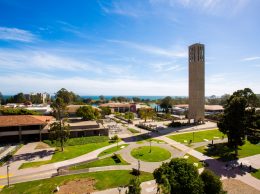By David Lea, Kyle Meng, Olivier Deschenes, Ranjit Deshmukh and Paige Weber
The world is jointly confronting two pressing issues: climate change and rising inequality. These problems are also intricately linked. The imperative to address climate change is overlaid on a world that is deeply unequal, which is likely to worsen under climate change. Yet, at the same time, there may be opportunities for well-designed climate policies that may also reduce existing inequities.
This is the challenge before California, and indeed the rest of the country, as evidenced by President Joe Biden’s recent announcement to cut U.S. greenhouse gas emissions by 50% in 2030 relative to 2005.
California’s goal, enshrined by then-Gov. Jerry Brown’s executive order in 2018, is to reach carbon neutrality by 2045. While the state’s carbon emissions have been generally falling since 2004, recent declines are smaller than what is needed to reach carbon neutrality by 2045.
One particularly important and stubborn sector is transportation. The production and consumption of fossil transportation fuels California contributes roughly half of California’s carbon emissions today, with an essentially flat trend in recent years.
Recognizing this, California’s 2019 Budget Act funded two University of California teams to examine various decarbonization pathways for California’s transportation sector, with a particular lens towards environmental and economic equity consequences.
One team, based at the UC Institute for Transportation Studies, studied the demand side of transportation fuel. Our team at UC Santa Barbara, consisting of Olivier Deschenes, Ranjit Deshmukh, David Lea, Kyle Meng, and Paige Weber, together with over a dozen graduate students, researchers, and staff, tackled the supply side, consisting of oil extraction and refining.
This analysis was released on April 23 as a report to the California Environmental Protection Agency titled “Enhancing equity while eliminating emissions in California’s supply of transportation fuels.”
There is no go-to model for understanding how the environmental and economic impacts of a managed decline in fossil fuel transportation supply in California is distributed across the state. Instead, our team of experts in energy systems, climate science, and health and labor economics had to build an empirically-grounded, spatially-explicit model of in-state oil extraction and refining from the ground up. Our model enabled us to explore nearly 2,000 different future decarbonization scenarios that reflect different statewide policies and macroeconomic conditions.
Reducing oil extraction and refining activity reduces local air pollution. But how that clean air is distributed across the state depends crucially on which oil wells and refineries are affected.
For example, if policies primarily phase out oil wells near disadvantaged communities, then more of the clean air benefits flow to disadvantaged communities, helping to narrow the current gap in pollution exposures between disadvantaged and other communities across the state. Likewise, if policies tend to affect less labor-intensive oil fields, the employment consequences may be smaller.
We find that a quota on oil extraction with auctioned permits has a built-in “equity benefit”: As air pollution falls, a greater share of that reduced air pollution exposure flows to disadvantaged communities. At the same time, increased setback distances between oil wells and where people reside (e.g., hospitals, daycares, schools) may shut down wells in less labor-intensive oil fields, allowing for smaller employment effects for the same total reduction in oil extraction.
Statewide, we quantify decarbonization scenarios that reduce extraction carbon emissions by 90% between 2019 and 2045.
Compared to a business-as-usual, no-policy scenario, these decarbonization scenarios are associated with cumulative reductions in total premature mortality and other adverse health outcomes of 17-37%, but also cumulative reductions in total employment in the extraction segment of 18-24%.
For refining, we find dramatic decarbonization harder to achieve. The most restrictive scenarios we modeled project that refining emissions decline by 56%-69% between 2019 and 2045. Compared to a business-as-usual, no-policy scenario, these restrictive decarbonization scenarios are associated with a cumulative decline in total premature mortality and other adverse health outcomes of 18-28% and reductions in refining employment of 18-30%.
Decarbonization in refining is more difficult because refineries are needed to continue to produce products such as liquid renewable fuels and jet fuel, the latter being a particularly persistent and difficult-to-decarbonize demand source. Decarbonizing refineries by 2045 will likely require use of carbon capture and storage and land-use solutions.
Globally, oil is a major contributor to climate change, and countries around the world are considering policies to phase out oil production. This issue recently made national news when the Biden administration suspended new leases of oil and gas extraction on federal lands. And Newsom recently directed the California Department of Conservation’s Geologic Energy Management Division to initiate regulatory action to end the issuance of new permits for hydraulic fracturing, or “fracking,” by January 2024.
The global community will continue to look to California’s progress, and our study provides another piece of the puzzle in understanding the many impacts of a transition to carbon neutrality.
• Kyle Meng, David Lea, Ranjit Deshmukh and Olivier Deschenes are faculty members at UC Santa Barbara, affiliated with the university’s Bren School Environmental Science and Management. Paige Weber is a professor at the University of North Carolina, Chapel Hill, an collaborator with UCSB’s emLab.






 Print
Print Email
Email

















